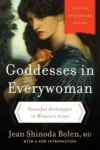What are the Archetypes of the Anima?

The concept of archetypes, as developed by Carl Jung, has been a powerful tool for understanding the human psyche. In particular, the exploration of feminine archetypes has provided invaluable insights into the unique experiences, challenges, and opportunities for growth that women face. This article delves into the realm of feminine archetypes, their shadows, and the therapeutic approaches that can help women navigate their inner landscapes and achieve greater wholeness and well-being.
The Seven Goddesses: A Framework for Understanding
One of the most influential works on feminine archetypes is “Goddesses in Everywoman” by Jungian analyst Jean Shinoda Bolen. Bolen identifies seven archetypal goddesses from Greek mythology, each representing a distinct aspect of the feminine psyche:
- The Mother
- The Queen
- The Lover
- The Maiden
- The Huntress
- The Wise Woman
- The Mystic
These archetypes serve as a framework for understanding the diverse experiences and potentialities of women, offering a language for self-discovery and growth.
The Shadow Side: When Archetypes Turn Dark
While each feminine archetype has its strengths and gifts, they also have shadow aspects that can emerge when a woman experiences trauma or faces challenging life circumstances. These shadow aspects can manifest in relationships, leading to imbalances and conflicts. Some examples include:
- The controlling and domineering Tyrant (shadow of the Queen)
- The emotionally distant and unavailable Neglectful Mother (shadow of the Mother)
- The manipulative Seductress (shadow of the Lover)
- The immature and irresponsible Eternal Child (shadow of the Maiden)
Recognizing and working with these shadow aspects is a crucial part of the therapeutic journey.
Archetypal Therapeutic Approaches: Healing and Transformation
Understanding and working with feminine archetypes can be a powerful tool for healing and transformation in therapy. By helping women identify and connect with their dominant archetypes, therapists can guide them in embracing their strengths and confronting their shadows. This process may involve:
- Exploring the origins of trauma
- Learning to set healthy boundaries
- Developing a more integrated and authentic sense of self
- Engaging with mythology and storytelling to tap into collective wisdom
- Celebrating the diversity of the feminine experience
Some specific therapeutic techniques for working with different archetypal shadows include:
- Assertiveness training and boundary setting for the Queen’s shadows
- Attachment work and inner child healing for the Mother’s shadows
- Exploring intimacy and vulnerability for the Lover’s shadows
- Inner child work and maturation for the Maiden’s shadows
- Anger management and empowerment work for the Huntress’ shadows
The Journey of Integration: Claiming Wholeness
Ultimately, the journey of exploring and integrating feminine archetypes is a deeply personal and transformative one. As women learn to embrace the full spectrum of their feminine nature, they can tap into a wellspring of strength, creativity, and wisdom. By becoming more whole and authentic, they can not only heal themselves but also contribute to the healing of the world around them.
Beyond Bolen: Further Archetypes and Explorations
While Bolen’s seven goddesses provide a rich starting point, there are many other feminine archetypes to explore, each with their own unique gifts and shadows. These include:
- The Wild Woman (Clarissa Pinkola Estés)
- The Sacred Prostitute (Nancy Qualls-Corbett)
- The Warrioress
- The Creatrix
- The Empress
- The Priestess
- The Healer
- The Muse
- The Rebel
- The Leader
- The Visionary
- The Teacher
- The Crone
- The Adventurer
- The Medial Woman
- The Matriarch
- The Wisecracker
- The Peacemaker
- The Environmentalist
- The Philanthropist
- The Judge
- The Shaman
- The Innovator
- The Diplomat
- The Seer
Each of these archetypes invites further exploration and integration, offering a rich tapestry of feminine experience and potential.
The study of feminine archetypes is a powerful tool for self-discovery, healing, and growth. By understanding the lights and shadows of these archetypes, women can navigate their inner landscapes with greater awareness and compassion. Through the therapeutic journey of integration, they can tap into their deepest strengths and wisdom, becoming more whole, authentic, and empowered. As they do so, they contribute to the collective healing and transformation of our world, one archetype at a time.
Bibliography
Bolen, Jean Shinoda. Goddesses in Everywoman: Powerful Archetypes in Women’s Lives. Harper Paperbacks, 2004.
Estés, Clarissa Pinkola. Women Who Run With the Wolves: Myths and Stories of the Wild Woman Archetype. Ballantine Books, 1996.
Jung, Carl Gustav. The Archetypes and the Collective Unconscious. Princeton University Press, 1981.
Myss, Caroline. Sacred Contracts: Awakening Your Divine Potential. Harmony, 2002.
Qualls-Corbett, Nancy. The Sacred Prostitute: Eternal Aspect of the Feminine. Inner City Books, 1988.
Woodman, Marion. Addiction to Perfection: The Still Unravished Bride. Inner City Books, 1982.
Further Reading
Campbell, Joseph. Goddesses: Mysteries of the Feminine Divine. New World Library, 2013.
Downing, Christine. The Goddess: Mythological Images of the Feminine. Continuum, 1996.
Murdock, Maureen. The Heroine’s Journey: Woman’s Quest for Wholeness. Shambhala, 1990.
Perera, Sylvia Brinton. Descent to the Goddess: A Way of Initiation for Women. Inner City Books, 1981.
Pinkola Estés, Clarissa. The Dangerous Old Woman: Myths and Stories of the Wise Woman Archetype. Sounds True, 2010.
Woodman, Marion. The Pregnant Virgin: A Process of Psychological Transformation. Inner City Books, 1985.
Jungian Topics
How Psychotherapy Lost its Way
Therapy, Mysticism and Spirituality?
The Symbolism of the Bollingen Stone
What Can the Origins of Religion Teach us about Psychology
The Major Influences from Philosophy and Religions on Carl Jung
How to Understand Carl Jung
How to Use Jungian Psychology for Screenwriting and Writing Fiction
The Symbolism of Color in Dreams
How the Shadow Shows up in Dreams
Using Jung to Combat Addiction
Jungian Exercises from Greek Myth
Jungian Shadow Work Meditation
Free Shadow Work Group Exercise
Post Post-Moderninsm and Post Secular Sacred
The Origins and History of Consciousness
Jung’s Empirical Phenomenological Method
The Future of Jungian Thought


























0 Comments